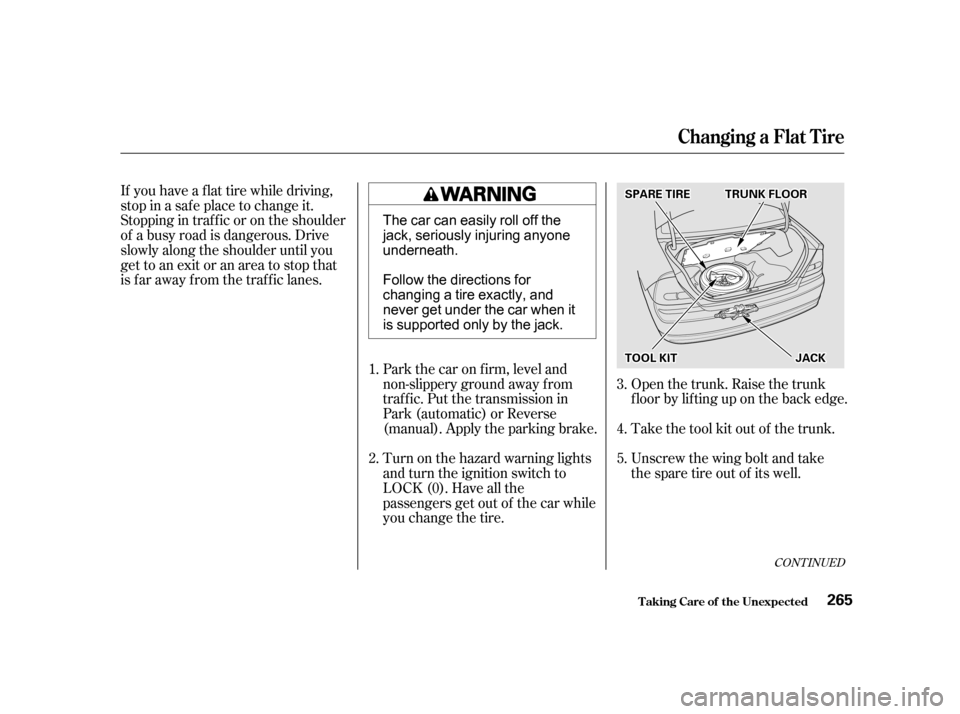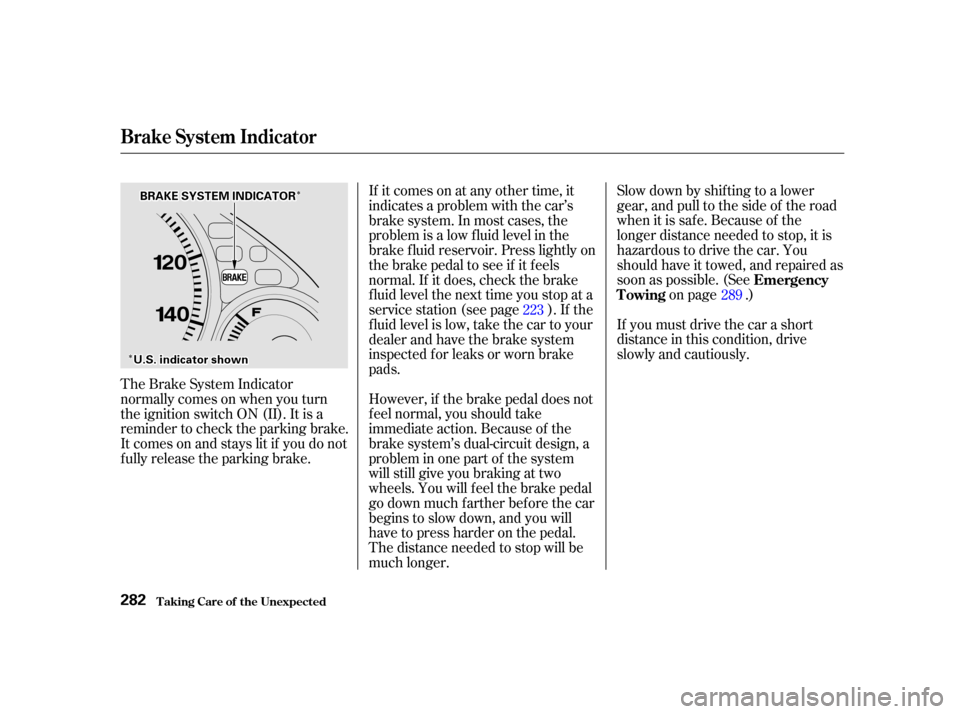Page 249 of 325
Check the f ollowing:
If youfindanybulbsareburnedout,
replace them as soon as possible.
Refer to the chart on page to
determinewhattypeof replacement
bulb is needed.Headlights (low and high beam)
Parking lights
Taillights
Brake lights
High-mount stop light
Turn signals
Back-up lights
Hazard light f unction
License plate light
Side marker lights
Daytime running lights
(Canadian models)
295
Lights
Maint enance246
B BAA C
CKK--U
UP P L
LIIGGH HT
T
S
ST TO
OP P/
/T
T A
A I
ILLL LIIGGH HT
T
S
SI
IDD E
E M
M A
AR
RKKEER
R L
LIIGGH HT
T H
HI
IGGH H-
-M
M O
OUUNNTT
S
ST TO
OP P L
LIIGGH HT
T
T
T
U
UR RNN S
SIIGGN NAAL
L L
LIIGGH HT
T
L
LIICCE EN
NS SEE P
PL
LAA T
TE
E
L
LI IGGH HT
TS
S
Page 254 of 325
Remove the socket f rom the light
assembly by squeezing the tabs on
both sides of the socket.
Pull the bulb straight out of its
socket. Push the new bulb in until
it bottoms in the socket.
Reinstall the socket. Turn it
clockwise until it locks. Make sure
the new bulb is working.
Open the trunk and remove the
socket f rom the light assembly by
turning it one-quarter turn counter-
clockwise.
Push the new bulb straight into
the socket until it bottoms. Pull the bulb straight out of its
socket. 2. 1.
3.
2. 1.
CONT INUED
Replacing a Rear L icense Plate
Bulb
Replacing a High-mount Brake
Light Bulb
Lights
Maint enance251
Page 257 of 325

Block the rear wheels.
Fill the f uel tank.
Change the engine oil and f ilter
(see page ).
Wash and dry the exterior
completely.
Cleantheinterior.Makesurethe
carpeting, floor mats, etc. are
completely dry.
Leave the parking brake off. Put
the transmission in Reverse
(5-speed manual) or Park
(automatic).
If you need to park your car f or an
extended period (more than one
month), there are several things you
should do to prepare it f or storage.
Proper preparation helps prevent
deterioration and makes it easier to
get your car back on the road. If
possible, store your car indoors.
If the car is to be stored for a
longer period, it should be
supported on jackstands so the
tires are of f the ground.
Leave one window open slightly (if
the car is being stored indoors).
Disconnect the battery.
Support the f ront wiper blade
arms with a f olded towel or rag so
they do not touch the windshield.
To minimize sticking, apply a
silicone spray lubricant to all door
and trunk seals. Also, apply a
vehiclebodywaxtothepainted
surfaces that mate with the door
and trunk seals.Coverthecarwitha‘‘breathable’’
cover, one made f rom a porous
material such as cotton.
Nonporous materials, such as
plastic sheeting, trap moisture,
which can damage the paint.
If possible, run the engine f or a
while periodically (pref erably once
amonth).
If you store your car f or 12 months
or longer, have your Honda dealer
perf orm the inspections called f or in
the24monthsmaintenanceschedule
(Normal Conditions) as soon as you
take it out of storage (see page ).
The replacements called f or in the
maintenance schedule are not
needed unless the car has actually
reached that time or mileage.
211
200
St oring Your Car
Maint enance254
Page 268 of 325

If you have a f lat tire while driving,
stop in a saf e place to change it.
Stopping in traf f ic or on the shoulder
of a busy road is dangerous. Drive
slowly along the shoulder until you
gettoanexitoranareatostopthat
is far away from the traffic lanes.Open the trunk. Raise the trunk
f loor by lif ting up on the back edge.
Take the tool kit out of the trunk.
Unscrew the wing bolt and take
the spare tire out of its well.
Park the car on f irm, level and
non-slippery ground away f rom
traf f ic. Put the transmission in
Park (automatic) or Reverse
(manual). Apply the parking brake.
Turn on the hazard warning lights
and turn the ignition switch to
LOCK (0). Have all the
passengers get out of the car while
you change the tire.
5. 4. 3.
2. 1.
CONT INUED
Changing a Flat T ire
T aking Care of t he Unexpect ed265
S SP PA
A R
REE T
TI
IRRE E T
TR
RU UN NKK F
FLLOOO ORR
T
T O
OO OLL K
KIITT J
JAA C
CKK
The car can easily roll off the
jack, seriously injuring anyone
underneath.
Follow the directions for
changing a tire exactly, and
never get under the car when it
is supported only by the jack.
Page 276 of 325

If your car’s battery has run down,
you may be able to start the engine
by using a booster battery. Although
this seems like a simple procedure,
you should take several precautions.
You cannot start a Honda with an
automatic transmission by pushing
or pulling it.To jump start your car, f ollow these
directions closely:
Open the hood and check the
physical condition of the battery
(see page ). In very cold
weather, check the condition of
the electrolyte. If it seems slushy
or like ice, do not try jump starting
until it thaws. Turn of f all the electrical acces-
sories: heater, A/C, stereo system,
lights, etc.
Put the transmission in Neutral or
Park and set the parking brake.
1.
2.
230
CONT INUED
Jump Starting
T aking Care of t he Unexpect ed273
A battery can explode if you do
not follow the correct procedure,
seriously injuring anyone
nearby.
Keep all sparks, open flames,
and smoking materials away
from the battery. If a battery sits in extreme cold, the
electrolyte inside can f reeze.
Attempting to jump start with a f rozen
battery can cause it to rupture.
Page 285 of 325

�Î
�Î�Î
�Î
Slow down by shif ting to a lower
gear, and pull to the side of the road
when it is saf e. Because of the
longer distance needed to stop, it is
hazardous to drive the car. You
should have it towed, and repaired as
soon as possible. (See
on page .)
If you must drive the car a short
distance in this condition, drive
slowly and cautiously.
If it comes on at any other time, it
indicates a problem with the car’s
brake system. In most cases, the
problem is a low f luid level in the
brake f luid reservoir. Press lightly on
the brake pedal to see if it f eels
normal. If it does, check the brake
f luid level the next time you stop at a
service station (see page ). If the
fluid level is low, take the car to your
dealer and have the brake system
inspected f or leaks or worn brake
pads.
However, if the brake pedal does not
f eel normal, you should take
immediate action. Because of the
brake system’s dual-circuit design, a
problem in one part of the system
will still give you braking at two
wheels. You will f eel the brake pedal
go down much f arther bef ore the car
begins to slow down, and you will
have to press harder on the pedal.
The distance needed to stop will be
much longer.
The Brake System Indicator
normallycomesonwhenyouturn
the ignition switch ON (II). It is a
reminder to check the parking brake.
It comes on and stays lit if you do not
f ully release the parking brake.
223
289Emergency
Towing
Brake System Indicator
T aking Care of t he Unexpect ed282
U U. .SS. .i
inn d
di
icca at too r
r s
shh o
ow
wn n
B
BR
RAA K
KEE S
SYYSSTTE
EM
M I
INND DI
ICCA A T
TO
OR R
Page 307 of 325
Then drive in city/suburban
traffic for at least 10 minutes.
When traf f ic conditions allow, let
the vehicle coast f or several
seconds without using the
accelerator pedal or the brake
pedal.
If the testing f acility determines the
readiness codes are still not set, see
your Honda dealer.
Select a nearby lightly traveled
major highway where you can
maintain a speed of 50 to 60 mph
(80to97km/h)foratleast20
minutes. Drive on the highway in
D (A/T) or 5th (M/T). Do not use
thecruisecontrol.Whentraffic
allows, drive f or 90 seconds
without moving the accelerator
pedal. (Vehicle speed may vary
slightly; this is okay.) If you cannot
do this f or a continuous 90
seconds because of traf f ic
conditions, drive f or at least 30
seconds, then repeat it two more
times (for a total of 90 seconds).
T echnical Inf ormation
St at e Emissions T est ing
304
Page 316 of 325

CONT INUED
...
Accessories and Modifications . 169
................................
Accessories .169
...
Additional Safety Precaution . 170
............................
Modif ications .170
ACCESSORY (Ignition Key .......................................
Position) .82
.............
Accessory Power Socket . 103
....................
Additives, Engine Oil . 209
.............................
Airbag (SRS) .10, 48
.....................
Air Cleaner Element .225
..............
Air Conditioning System . 108
......................
Maintenance .234, 235
.........................................
Usage .108
.......................
Air Outlets (Vents) .110
.......................
Air Pressure, Tires .238
.........................
Normal Driving .239
.......................
Alcohol in Gasoline .298
......................................
Antif reeze .213
Anti-lock Brakes (ABS) ....................
Indicator Light .62, 192
...................................
Operation .190
Anti-thef t Steering Column ..............................................
Lock .82
..........................
Appearance Care .255 ................
Audio System . 116,128,140
...............
Automatic Speed Control . 76
..............
Automatic Transmission . 180
..........................
Capacity,Fluid .294
...............
Checking Fluid Level . 220
.......................................
Shif ting .181
.
Shif t Lever Position Indicator . 180
................
Shif t Lever Positions . 181
....................
Shif t Lock Release . 184
Battery Charging System ...........................
Indicator .62, 278
............................
Jump Starting .273
..............................
Maintenance .230
............................
Specif ications .294
..............................
Bef ore Driving .161
....................................
Belts,Seat .8,44
...........................
Beverage Holder .102
.................................
Body Repairs .262
Brakes ...........
Anti-lock System (ABS) . 190
.............
Break-in, New Linings . 162
............
Bulb Replacement . 250,251 ...........................................
Fluid .223
.......................................
Parking .100
.................
System Indicator . 62,282
........................
Wear Indicators .189
.............................
Braking System .189
........................
Break-in, New Car .162
..
Brightness Control, Instruments . 71
........................
Brights, Headlights .70
Bulb Replacement ..........................
Back-up Lights .251
..............................
Brake Lights .250
..............................
Ceiling Light .253
................
Front Parking Lights . 248
........
Front Side Marker Lights . 248
.................................
Headlights .247
.........
High-mount Brake Light . 251
.................
License Plate Lights . 251
.........
Rear Side Marker Lights . 250
............................
Specif ications .294
...................................
Spotlights .253
...............................
Trunk Light .252
....................
Turn Signal Lights . 248
..............................
Bulbs, Halogen .247
Index
A
B
I